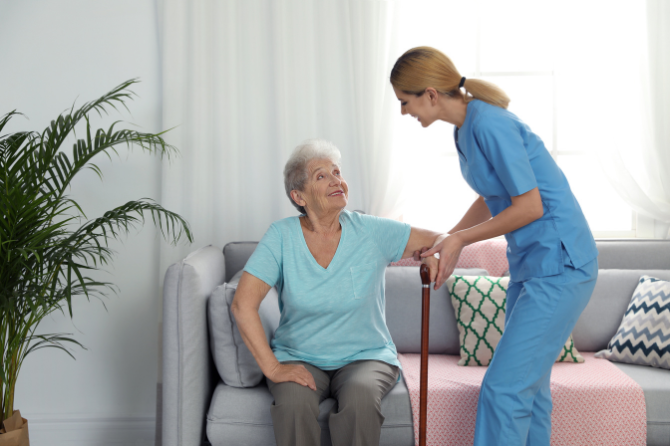
As we age, our risk of falling increases, but that doesn’t mean falls are an inevitable part of growing older. In this comprehensive guide, we’ll delve deep into the causes of frequent falls among the elderly, discuss common complications that can arise, and provide practical tips on how to prevent falls and maintain a safe, independent lifestyle. Plus, we’ll introduce you to valuable resources at OakBend’s ACE Unit and OakBend’s Skilled Nursing Facility, designed to support seniors in their journey to fall prevention and overall health.
Causes of Frequent Falls in the Elderly
Falls among the elderly can be attributed to various factors, and understanding these causes is crucial in implementing effective fall prevention strategies:
- Age-Related Changes: As we age, our balance, vision, and muscle strength naturally decline, making us more prone to falls. These changes can affect our ability to react quickly to prevent a fall. Engaging in regular exercise that focuses on improving these areas can help mitigate these effects.
- Medical Conditions: Certain medical conditions, such as osteoporosis, arthritis, and Parkinson’s disease, can increase the risk of falls. Chronic illnesses may affect mobility and coordination, making falls more likely. Proper management and treatment of these conditions, under the guidance of healthcare professionals, are essential.
- Medications: Some medications, especially those that cause dizziness or drowsiness, can contribute to falls. It is essential to review and adjust medications under the guidance of a healthcare professional. Communication with your doctor or pharmacist is key to ensuring medication regimens are as safe as possible.
- Environmental Hazards: Hazards in the home environment, like loose rugs, cluttered pathways, and poor lighting, pose significant fall risks. Identifying and addressing these hazards is a crucial step in fall prevention. Consider installing handrails and grab bars, securing loose cords, and ensuring good lighting throughout your home.
Common Complications of Falls in the Elderly
Falls can have severe consequences, both physically and emotionally:
- Fractures: One of the most common outcomes of falls is bone fractures, especially in the hip, wrist, and spine. These fractures often require surgery and lengthy rehabilitation. Building and maintaining strong bones through a balanced diet rich in calcium and vitamin D can help reduce the risk of fractures.
- Head Injuries: Falls can lead to head injuries, ranging from mild concussions to severe traumatic brain injuries. Head injuries can have lasting cognitive and functional effects. Wearing a properly fitted helmet when engaging in activities with a risk of head injury, such as cycling or skating, can provide an added layer of protection.
- Psychological Impact: Experiencing a fall can lead to fear and anxiety about falling again, which can limit mobility and independence. This fear can have a significant impact on an elderly person’s quality of life. Engaging in activities that boost self-confidence and balance can help overcome this fear.
- Impact on Overall Well-Being: Falls can result in reduced physical activity and social isolation, which, in turn, can lead to a decline in overall health and well-being. Staying socially active and maintaining a healthy diet can combat these effects.
Prevention Strategies
Preventing falls among the elderly involves a multifaceted approach. Here are some practical strategies to reduce the risk of falls:
- Regular Exercise: Engage in regular physical activity to improve balance, strength, and flexibility. Activities like tai chi, yoga, and strength training can be particularly beneficial. Consider joining a local senior exercise class or group to stay motivated.
- Home Modifications: Assess your home for potential hazards. Remove clutter, secure rugs, install grab bars in bathrooms, and improve lighting in hallways and stairwells. Consider consulting with a professional home safety evaluator for a thorough assessment.
- Proper Footwear: Wear supportive, non-slip shoes with good traction both indoors and outdoors. Avoid walking in socks or slippers. Shoe stores that specialize in fitting seniors can help you find the right footwear.
- Vision and Hearing Checks: Regularly visit your eye and ear healthcare professionals. Correcting vision and hearing problems can reduce the risk of falls. Additionally, consider regular eye exams to keep your prescription up-to-date.
- Medication Management: Review your medications with your doctor or pharmacist. They can help identify and adjust medications that may increase the risk of falls. Make a medication schedule and set reminders to ensure you take them as prescribed.
- Regular Check-Ups: Schedule regular check-ups with your healthcare provider to monitor your overall health and address any concerns promptly. Routine check-ups can catch potential issues early and allow for prompt intervention.
- Nutrition and Hydration: Proper nutrition plays a pivotal role in maintaining overall health and preventing falls. A balanced diet rich in calcium and vitamin D helps in strengthening bones, reducing the risk of fractures. Adequate hydration is equally vital as it helps to maintain muscle function and cognitive abilities. Ensure you drink enough water throughout the day, especially in hot weather.
- Social Engagement: Staying socially active can significantly impact fall prevention. Loneliness and social isolation can lead to depression and reduced physical activity. Joining clubs, attending community events, and staying connected with family and friends provide emotional support and encourage an active lifestyle.
- Assistive Devices: For those with mobility challenges, consider the use of assistive devices like walkers, canes, or wheelchairs. These devices can provide stability and support, making it easier to move safely both indoors and outdoors.
- Education and Awareness: Knowledge is a powerful tool in fall prevention. Attend workshops or classes on fall prevention to learn more about specific exercises and strategies tailored to the elderly. Education empowers individuals to take proactive steps in reducing their fall risk.
By incorporating these additional strategies into your fall prevention plan, you can further enhance your safety and well-being as you age.
Conclusion
Falls can have significant physical, emotional, and financial consequences for the elderly. However, with the right knowledge and proactive steps, falls can often be prevented. By implementing the strategies discussed in this comprehensive guide, including nutrition, social engagement, assistive devices, and education, along with seeking support from dedicated facilities like OakBend’s ACE Unit and OakBend’s Skilled Nursing Facility, you can reduce the risk of falls and enjoy a healthier, safer life as you age.
If you or a loved one are looking for specialized care and support in fall prevention and senior health, explore OakBend’s ACE Unit here and OakBend’s Skilled Nursing Facility here to learn more about their services and how they can assist you on your journey towards fall prevention and overall well-being.
Leave a reply







